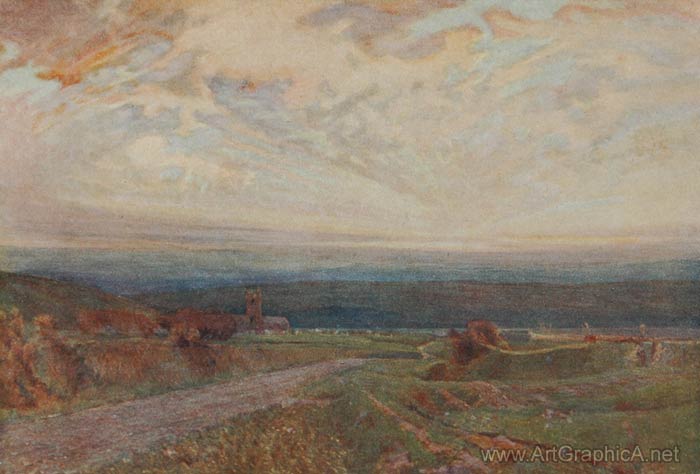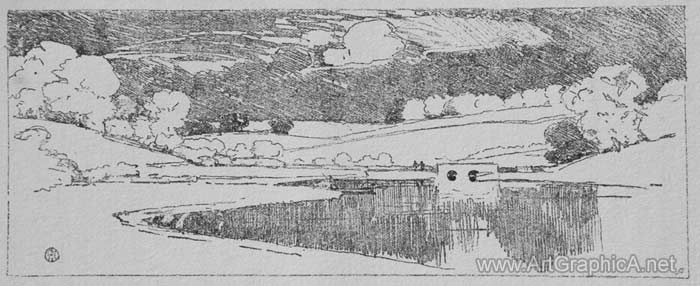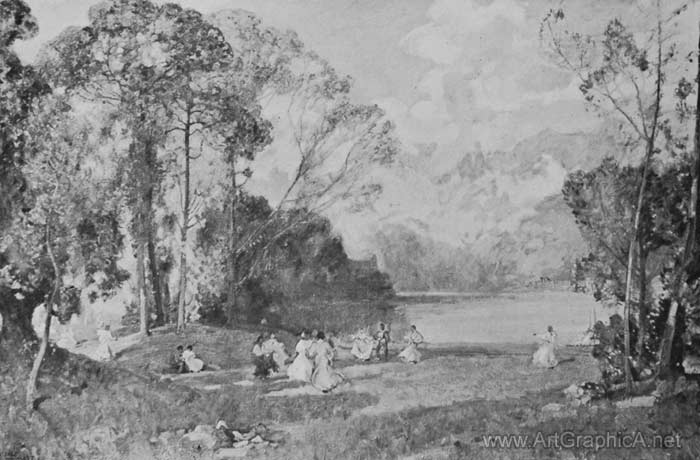Painting the Sky |
|||||||||||||||||||||
|
Page 09 / 14
SKIESCHAPTER VIIIIF you make a practice of painting the sky every morning with I the regularity that you take your bath, you will find at the end of six months that you know something of its variations. Perhaps the most convenient medium for this purpose is watercolour or pastel, but do them in oil by all means if you can, though the time lost in setting your palette robs you of the limited time you have at your disposal, for the clouds are changing every moment. Half-an-hour is sufficient, for I do not want you to make the practice a fag, or to take too much of the energy you must reserve for your ordinary work. Therefore, if you devote the half-hour immediately before breakfast to this purpose, you will find it the most convenient time of the day. Be sure you draw your sky, and if you cannot finish it in the limited time, paint that part which is interesting. You can take a few notes in writing on your paper or your panel, as the case may be, of the characteristics you have not caught. They, with the bit of colour, will be most useful. Apart from their use as studies, you will find that the practice will widen your knowledge of what is likely to happen under certain atmospheric conditions. Do not forget to date your sketches and note the hour, and the direction and strength of the wind. If you paint a clear blue sky, you make a study of its tone and gradation, its warmthr coldness. ness. Or you may have one of thin high cirrus, where the detached cloudlets float miles above you, interesting individually, and still more interesting in their aggregate. You may note how they are lit, and how far the light impinges upon their edges, or influences the effect of their density, as shown by their opacity or otherwise. You may watch a wandering piece of cumulus moving at a lower altitude under the influence of a different current of air, and you will see how advantageous its form is in contrast with the mottled appearance of the cirrus. You will see the interesting phenomenon of one cloud passing under the shadow of another which has just intervened between it and the sun ; and as it clears itself from its eclipse, you will note the revelation of its modelling by the contour of its shadow. You may find one morning high masses of cumuli, such as we see after rain, moving slowly and majestically across the sky, towering up and up, till their tops outvie the highest mountains, you will note their form and movement, their edges defined against the blue by a line which is felt rather than seen, giving them, with the shadow on the opposite side from the sun, their rounded forms. How nobly they sail across the sky, or, on a hot day, hang tranquilly in that ineffable blue which is so difficult to paint. You observe the distances between these masses; you see the perspective of one great cloud behind the other, how they slowly approach, till at length they form a great spectacle of white and soft grey. Through their interstices you get a glimpse of the blue, made many times more intense by its isolation. As the day grows to noon, they pass along their celestial path till, in the evening, they shelter themselves on the line of the extreme distance, where the low sun lights them with his effulgent glory. Above the belt of long strata they lie, gradually changing from grey to gold, from gold to purple as the sun's rays slant upwards from behind, and gloom rests upon the purple hills. It is absorbing thus to watch a sky from dawn to sunset (say in September when the days are short enough to do so), and one may profitably devote a whole day to the study when the sky is particularly interesting. In the sketches I have given you facing page 90, you will see that they all represent the same scene, but in different aspects, from dawn to sunset, and they illustrate not only what may be made of a common. place subject by the selection of an effect, as I have stated elsewhere, but the enormous importance of the relation of the sky to the landscape.  The Lonely Road. Do each sketch at one sitting, which must of necessity be short. You will find a great deal to learn that you had not anticipated. You will see shadows, reflections, and reflected lights, all which, carefully observed, build up the wonder of your sky and, if painted well, cannot fail to be interesting and beautiful. Let me give you a few hints about painting a sky. In the first place you must, as I have just said, do it justice in one painting ; but before making the attempt, prepare your canvas with a coat of white, tempered with yellow ochre, which should be painted with crisp firm touches, using very little medium, the touch firmer and stronger as your work extends from the horizon to the zenith. Beware of a dead flat surface; do not brush it too much, as in painting at all times your touch should be confident. After the preliminary coat of paint is dry, you may scrape off any unpleasant projections left by your brush at the previous painting, and you will have a very agreeable surface to work upon. Then with white and yellow ochre you paint it exactly as you have done before, taking care to cross the brush marks, and after you have done this you paint your blue into the wet paint. You will discover that your blue will be a little stronger, since it will mix with the wet paint which forms the ground. I will now speak of painting a plain blue sky, since I have already spoken of clouds and their treatment. The blue must, of course, depend upon the colour in Nature, and that which is in sympathy with your landscape ; but, generally speaking, your sky palette is composed of the following :--White, yellow ochre, cobalt or French ultramarine, viridian, and rose madder or Venetian red, very much diluted with white. Now paint a touch composed of the first four. If you find it too intense a blue, add a little more white and yellow ochre and a mere touch of raw umber. If you find it too green add more blue and white. Then with different quantities of the slightest possible difference of colour, paint another touch by the side of the former ; then paint one with a distinctly red side, another to the yellow side, another to the blue side, and another to the green side ; then step back and see the general effect, which, of course, should be blue. At the horizon you will see no blue, or scarcely any; in its place use the slightest touch of raw umber or Venetian red and yellow ochre, according to the effect. You must be careful, for you will find the merest touch of blue is too much, and is most extraordinarily deceptive.  A coming storm. (From a soft ground etching). Your extremely distant sky should be painted with small, independent touches, edge to edge, with the slightest possible difference of colour, very much diluted with white, but still a difference which can be detected upon very close inspection. These should be placed at the horizon, in a contrary way to the prismatic arrangement, and this method, instead of giving you a rhythm of colour, will give a feeling of vibration, because the tones will be very slightly contrasting or complementary, so that you will discover, although looking like a flat tone, it is really composed of many separated colours. This is one of the most difficult things to accomplish, and you will, no doubt, meet with many failures. You may get it too light or too dark at first, and too near in perspective ; but never mind failure, try again, for when it is properly accomplished you will have given the impression of great distance, and of moving air, heated by the surface of the earth. You have now to join the colour of the horizon with the touches of blue you have already placed on your canvas higher up. The gradation must be very carefully done, still following the method of placing the colours side by side, increasing the area of the touch and the necessary slight alteration of colour, more blue and less of the warmer tints, until you join the blue, which is the general effect of the sky. Your warm touches are now more or less deepened with blue of slightly different shades, but of the same tone, until you reach the top of your canvas, where you can have large passages of plain colour. Now carefully look over the sky as a whole. You will probably see that your gradation is much more abrupt than in Nature. That is to say, your sky changes more suddenly from the distance (where it partakes more or less of the colour of the extreme distance of the landscape) to the blue of the zenith But that is as it should be; for if you take the relative space in Nature that you have taken in the picture between the horizon and the top of your canvas, you would find that the gradation in Nature was very small in that limited distance. By the quicker transition you obtain that sense of infinity which is a greater fact and of more importance than the actual truth.  An Idyll of Como. In conclusion, I wish to draw attention to the tonal " pitch" of your sky. Since it is quite out of the question that you can get the exact tone of a sunlit landscape, it must be some degrees lower than Nature. It stands to reason that your sky must harmonise with Nature, and further the composition and colour of your trees and grass must also be in sympathy with the forms, as well as the colour, of your sky. And as you cannot alter the composition of your trees to suit your sky, your best plan will be to paint the forms and colour of your sky to suit your trees. That is why I advise you when laying in your first painting, simply to paint a preparatory ground for your sky, which is afterwards to receive its final painting. When your landscape is partly done, the preparatory painting at that stage will, of course, receive your careful attention. Don't be afraid of rubbing the foliage into the sky, and the sky into the foliage at your first painting. You will have ample opportunity of getting the character of the edge when you are painting the sky at a later stage, and then the very greatest care must be exercised in the matter. It is useless to lay down any definite rules on cloud forms suitable for any particular picture, because there are so many factors which govern and qualify them. The sky must be felt upon all surfaces which are capable of reflecting it, not only in the pool of water, but from every blade of grass, from every flag by the waterside, from every leaf, roof, and road. That is what may be understood as being in sympathy with the landscape. Always remember that it is the reflected light of the sky added to the local colour of each object that makes up the general tone of the landscape. It is not only sunshine and distance that give it colour, but an aggregate of a million little reflections.• The essential truths of the sky are its immensity, its infinity, and its purity. Aim at securing these qualities, and you will have a fine sky. Let your landscape be in relation to your sky, and your sky to your landscape. In so doing you will certainly have attained some of the high truths which go to make up a worthy picture. * See chapter on Painting Reflections
Next Page
Prev PagePainting Grass Painting Trees
|
|||||||||||||||||||||








